
Honors Summer Research Institute (HSRI)
An eight-week summer program where Dorman Scholars conduct faculty-mentored research, connect across disciplines, and complete a research milestone.
The Honors Summer Research Institute (HSRI) is an eight-week summer program intended to foster and promote interdisciplinary collaboration among Honors Scholars engaging in summer research with an NJIT faculty mentor or through an affiliated entity. Participating scholars learn about the wide-range of research conducted at NJIT through peer research presentations and discussions. The HSRI is a research milestone experience and scholars who participate fully will receive an honors course reduction.
The HSRI is open to all Honors Scholars conducting full-time, on-campus research during the HSRI period. Some examples of research experiences that would provide such research include the NJIT Provost Summer Research Fellowship, NJIT NSF REU programs, department- or faculty-sponsored research or assistantships. At the time of application to the HSRI, scholars must have an established relationship with an NJIT faculty member willing to serve as the applicant’s research mentor.
The HSRI is a unique educational, social, and research training opportunity. HSRI Scholars will work together with other scholars to learn how to present their research and how to critically review their peers’ research. The program concludes with presentations and awards at the NJIT International Summer Undergraduate Research Symposium on July 23 - 24, 2025.
Several funding options have been available for scholars to participate in this program over the past several years, such as through the Provost Summer Research Fellowship or an Honors College summer research award thanks to the generous support of ADHC alumni and friends. Below are the various Honors College awards which have been available to sponsor Honors Scholars’ full participation in the HSRI program and corresponding full-time research.
- Honors Summer Research Institute (HSRI) Grant
$3000 stipend, 8 weeks
Funded by the ADHC Dean’s Fund for Student Development
Applications from all disciplines will be accepted and considered.
- The Honors College Moonshot Grants for Engaged Scholarship
$5000 stipend and a $1500 budget, 10 weeks, 1 recipient
Funded by Rohini Kadle, MD and Vatsal Shah, PhD, PE '08H, '09, '15
The Honors Moonshot Grants develop and recognize bold, interdisciplinary projects that apply the unique technical abilities and training of Honors Scholars to important social and cultural questions. Ideal projects find innovative approaches that address major issues of common concern in an engaging manner that both helps raise awareness of, and resolve the problem. Local solutions to global challenges are particularly welcome. (In the event that a group project is selected, the total award may be given to the group based on the recommendation of the review committee).
- The Honors College "Life on the River" Grants
$3500 stipend, 8 weeks
Funded by the ADHC Dean’s Fund for Student Development
The Honors College "Life on the River" Grants support the interdisciplinary study of the history and impacts of the Passaic River on neighborhoods in Newark, NJ. Grantees will receive funding to support their efforts to collaborate with local stakeholders to learn about communities' experience of the river and to identify possibilities for engineering solutions to address local needs. Grantees will learn systems thinking and use a variety of historical, anthropological, and engineering methods to collect and analyze the data they gather and will present their findings both at the NJIT International Summer Undergraduate Research Symposium and to community stakeholders. Students will receive support from a faculty advisor as well as a professional engineering consultant to complete their research. This research will help us launch ENGR 493 Honors - Service Learning for Engineers in the Spring of 2026.
- The Honors College Langan Grant in Civil and Environmental Engineering
$3500 stipend, 8 weeks, 1 recipient
Funded by Langan Engineering, Stewart Abrams, Principal, ADHC Board of Visitors
The Honors College Langan Engineering Grant supports proposals within the field of Environmental Engineering or Environmental studies broadly defined.
- The Honors College ANS Geo Grant
$3500 stipend, 8 weeks, 2 recipients
Funded by ANS Geo, Inc., Vatsal Shah, PhD, PE '08H, '09, '15, Principal Engineer
The Honors College ANS Geo Grant supports an outstanding project in civil or environmental engineering or related projects.
| Melna Abraham and Arianna Alves | Audiobook/Podcast Interface Study |
| Ciara Adams | Assessing Vergence Speed from Virtual Reality System and Vergence Facility as a Potential Biomarker for Concussions |
| Neil Ahlawat | Dynamic Characterization of Combustion of Powders of Reactive Materials |
| Pranav Anthapu | Creating a GUI to Analyze Motor-Evoked Potentials |
| Darren Bonifacio | Personality Classification Using Natural Language Processing |
| Lindsay Burke | Navigating by Nature: Harnessing Birdsong for Spatial Perception |
| Kristina Camia | Understanding the Mechanism for Handedness Transformation in Eusocial Snapping Shrimp |
| Austin Chen | Validating Ground Heat Transfer Models for a Net-Zero House with Basement |
| Diandra Debnath | Using blue light stimulation to activateDmrt3a neurons, a genetically conserved spinal interneuron class, for gait-specific limb use in larval zebrafish |
| Anushka Dixit | Optimizing the Quantification of Process-Related Impurities in Monoclonal Antibodies |
| Dev Doshi | Using AI Prediction & Genetic Analysis of the Protocadherin Gene Cluster to Improve Diagnosis Yields of Pathogenic Variant Carriers in Diverse U.S. Populations |
| Saketh Golla | Machine Learning Models to Predict Cholera Infection in an Ottoman Asylum |
| Sathvik Gopu | Breast Tissue Synthesis to Improve Cancer Detection |
| Keya Gulati | Molecular Cloning of Neurodevelopmental Disorder Associated G3BP1 Mutants |
| Steven Habeb | The Effect of Perfluorooctanesulfonic Acid (PFOS) on Ovarian Follicles |
| Yash Kumar Jain | Analyzing Spatiotemporal Variations of Harmful Algal Blooms in New Jersey Lakes using Artificial Intelligence Techniques and Statistical Tests |
| Meera James | Design of novel autoimmune antibody-binding peptides in silico |
| Wafiza Julkipli | Influence of Ultrasound Responsive Xenon Microbubbles on Blood-Brain Barrier Repair following Traumatic Brain Injury |
| Jane Kalla | The Impact of Visual Clutter on Emotion Recognition in Video Conferencing |
| Aakash Karlekar | Applying Parallelism to Optimize the Backpropagation Algorithm |
| Marwan Kashkoush | Determining if the HCS Independence Finding Holds at Higher Latitudes |
| Audrey Kormann | Carbon Dioxide Nanobubbles to Enhance Biodegradation in Food Waste Digesters |
| Aaradhya Kumar | Optimizing Bioink Formulations for 3D Bone Bioprinting |
| Robert Lodge | Morphological Changes in Neuroinflammation Markers After Blast Injuries |
| Mukund Maurya | Formulation of Novel Ultrasound Theragnostic using Protein Nanodroplets for Treating Cancer |
| Aayush Mehta | The Role of MMP-12 in Inducing Caspase-3 Regulated Apoptosis Following Repetitive Low-Level Blast Injury |
| Margaret Meschia | Tracking Mechanisms of Phthalate Toxicity in Mouse Ovaries |
| Arush Mishra | Developing an Objective Software Toolkit to Assess Pupil Asymmetry |
| Salma Mohammed | Analysis of Exoskeleton-Patient Interaction during Exoskeleton-Assisted Locomotion using 3-D Motion Capture and Computer Simulations |
| John Mohring | Immersive Design: Amplifying User Learning with Gamification in VR |
| Aryan Mudaliar | The impact of environmental pH changes on Mauthner cell development in Astyanax mexicanus |
| Albin Mullan | Quantifying the Mechanical Competence of the Proximal Femur Using Finite Element Analysis |
| Melissa Nanotkar | pH-Responsive Oligomers for Nucleic Acid Therapy |
| Stephanie Ng | The comparison of PAA and electrospun polyaniline nanofibers in the creation of pain biosensors |
| Rain Nutt | Examining Relationships Between Mood and Music Listening Habits |
| Udochukwu (Laura) Nwanebu | An Ultrasound-Based Chemical Kinetic Model for Unraveling the Mechanism of Decomposing Per- and Polyfluoroalkyl Substances (PFAS) |
| Arwa Ouali | Utilizing Ultrasounds to Decompose Microplastics |
| Taylor Pape | The Effects of Neuromodulation on the Stability of Neuronal Activity: A Computational Modeling Approach |
| Jaiman Parekh | The Role of Quadrupolar Magnetic Fields in Initiating a Coronal Mass Ejection |
| Alex Patchedjiev | Geographical Data Visualization & Analysis for Roman Street Shrines |
| Vidhi Patel | Role of Stromal Cells for Breast Cancer Invasion in an Engineered Tumor Model |
| Tramina Phan | Exploring the Synthesis of Sequence-Defined Mixed Alpha-Amino and Beta-Amino Esters and Evaluating Their Effectiveness and Toxicity In Cells |
| Isabella Puluse | An Analysis and Optimization of the Factors That Impact Anaerobic Digestion and Biodigester Efficiency |
| Simritt Rai and Rhea Sansguiri | CDC42 Molecular Mechanism in Colorectal Tumors |
| Grace Revoredo | Are human interaction biases employed when using cross-species communication signals? |
| Sophia Rollo | Quantifying Beak and Respiratory Movement of Zebra Finches Using DeepLabCut |
| Harish Sekar | Assessing the Exoskeletal-Assisted Locomotion of Adults with SCI through 3D Motion Analysis Techniques |
| Srinesh Selvaraj | Creating a Multi-User Virtual Reality System for Ontology Visualizations |
| Olena Sen | Analytical Software Technique for Determining the Natural Frequencies of Pupillary Responses in Vergence Eye Movements |
| Jainam Shah | Enhancing Generalization and Accuracy in Predicting Days of Maintenance Delay for U.S. Navy Ships |
| Rohan Shah | Quantifying Global Learning: A Data-Driven Analysis and Visualization of the Study Abroad Experience |
| Arya Shahane | Upstream Migration of Natural Killer Cells |
| Luke Shen | Autonomous Robot Self-Assembly Inspired by Slime Mold Growth |
| Kabir Singh | Development of a novel male contraceptive using cyclic peptides to inhibit fertilization |
| Girish Subramani | Sequence-Defined Polyester Oligomers for Nucleic Acid Therapy |
| Dhanya Sureshbabu | Nature vs. Nurture: The Study of Environmental Influences on Astyanax Social Development |
| Jonas Tirona | Increasing Digital Accessibility of NJIT’s Online Learning Presence |
| Om Tripathi | Factors Associated with Research Productivity and NIH Funding in Academic Rhinology |
| Caroline Vierheilig | Characterizing the Baseline Energy Use for NJIT Campus Buildings: Leveraging High-Resolution Data |
| Maharshi Vyas | A Statistical Analysis of Student Voice Trends in NJIT's The Vector |
| Nader Zahran | Point of Care Devices for Zoonotic Disease Detection |
| Omar Al-Zaman | Synthesis and Characterization of Ruthenium Based Photosensitizer Compounds |
| Don Bonifacio | Tax Fraud Detection Using a Machine Learning Approach |
| Larissa Cavalcante | Tensile Failure in Enhanced Geothermal Systems due to Heat Energy Extraction |
| Sagnik Chowdhury | The Effect of Deepfakes on College Students’ Political Opinions |
| Evan Correa | Investigating the Effect of Optogenetically Activating Dmrt3a in Larval Zebrafish |
| Kevin Diggs | Soundly Detecting Memory Leaks in the Linux Kernel |
| Anushka Dixit | Applying Ultrafast Protein Digestion in Microdroplets to Hydrogen-Deuterium Exchange Mass Spectrometry (HDX-MS) |
| Fatimah El-Belkasi | The Implications of Visual Stimuli on Conferencing Platforms |
| Joel Florim | Monitoring Water Conductivity due to Splash and Spray to Optimize Road Salt Use |
| Oluwanifemu Fuwa | Algae separation using Recoverable Magnetic Particles |
| Dylan Ton-That and Salma Ghazi | Real-Time Temperature Profile Forecasting in Metal Additive Manufacturing |
| Saketh Golla | Studying the Impacts of Cholera on the Mentally Ill in the Ottoman Empire |
| Sathvik Gopu | Computational Methods for Human-Centered Perceptual Analysis of Work Spaces |
| Oliwia Gorska | Epigenetic Signatures for Age-at-Death Estimation in Human Remains |
| Steven Habeb | The Effect of Perfluorooctanesulfonic Acid (PFOS) on Ovarian Follicles |
| Allison Harbolic | Identifying the Distribution of Nano Plastics in Mouse Placenta |
| Vidhi Dholakia and Sriya Jidugu | The Order of Madness: Patient Categorization in the Toptasi Asylum |
| Michelle Jojy | Effects of Nanoplastics on Gene Expression in the Placenta |
| Haripriya Kemisetti | Inattentional Blindness Paradigm: Can You See the Forest for the Trees? |
| Mason Kovach | Virtual Analysis of Hip, Knee, and Ankle Joints during Exoskeletal-Assisted Locomotion |
| Jeremy Kurian and Ari Kamat | Simulating Patient Behavior with Machine Learning: Case of an Ottoman Mental Institution |
| Peter Kmutuzov | Determining the Synergistic Effects of ECM Coating and Neurotrophic Factors on Neuronal Growth in Collagen Gel 3D-Model |
| Samuel Levshteyn | The Effect of Background Complexity on Ensemble Perception in Video Conferencing |
| Hehjun Lim | Identifying Fashion Trends Using Color Analysis |
| Robert Lodge | Liraglutide & Neural Recovery After Repeated Blast Traumatic Brain Injury |
| Ayman Mohammad | Neuromodulatory Contribution to Temperature Robustness of Locomotion |
| Aliza Mujahid | Enhancing Skin Grafting Efficiency: A New Method for Estimating Skin Expansion Ratio Based on Skin’s Geometric and Mechanical Properties |
| Vignesh Nethrapalli | Improving Caption Data Diversity via Mood-Amplification for Audio-Language Tasks |
| Jaiman Parekh | Nonlinear Water Waves |
| Suhas Parise | The Effect of Immunopeptides on the Triple-Negative Breast Cancer T-Cell Activation |
| Alex Patchedjiev | Roman Street Shrine Database and Querying Interface |
| Disha Patil | Using DTI to Study Changes in White Matter Tracts in the Brain to Identify Mild TBIDiffusion Tensor |
| Pia Piazza | Rheological Characterization of Concentrated Emulsions in Shear Flows |
| Dharam Shah | Prediction of Process-Property Relationship in Metal Additive Manufacturing |
| Soham Shashikumar | Understanding the Pathophysiology of Persistent Post Concussion Symptoms with Convergence Insufficiency: an Analysis of Cerebral Blood Flow in Concussed Patients |
| Dhanya Sureshbabu | Observing the Occurrence of Panic in Astyanax mexicanus |
| Sarah Abdul | Curing Madness: Ottoman Psychiatric Treatments in the 19th Century |
| Kamil Arif | ForensicXR |
| Theresa Carlos | Exploring the Impact of Traumatic Brain Injury on Functional Brain Connectivity using fMRI Data |
| Jonah Eng | Inferring the Properties of Neuronal Synaptic Connectivity: A Combined Dynamic Modeling and Machine Learning Approach |
| Elizabeth Finnegan | Controlling Madness: Constructing Space and Time for Toptaşı Asylum Staff |
| Shaik Hassan | Investigating the Impact of ECM Proteins on Spinal Cord Injury and Repair |
| Erika Hurst | Avatar Creation in Education and the Metaverse |
| Mrunmayi Joshi | Neuronal Loss after Repeated Low-level Blast Injury |
| Nikola Klimczak | Compounding Impacts of Climate Change and Ambient Temperatures on Mortality |
| Priya Marella | Role of TGFβ Signaling in Wound Healing |
| Roberto Martinez | The Effect of Surfactant on the Glass Transition Temperature of PLGA Nanoparticles |
| Charan Masimukku | The Secularization of Italy and Prevalence of Vernacular Devotion |
| Varun Pai | The Role of the Hog1 Pathway in Candida auris Drug Resistance and Cell Wall Architecture |
| Dhruvi Prajapati | Using NMR to Quantify the Degradation Efficiency of PFAS Treatment |
| Prithvi Rajbabu | Investigating the role of the neuronal class, Dmrt3, in the control of locomotion and fin movement in zebrafish |
| Vishva Rana | Air Quality Monitoring System in the Ironbound |
| Anbar Saleem | Interactive Annotated 360 Environments for Educational Use |
| Dinitha Samaranayake | Computational Exploration of the Gewald Reaction |
| Pushti Shah | Assessing Subject Motion in Task-based and Resting-state fMRI scans. |
| Taylor Van Grouw | From Conserved to Forgotten: An Analysis of the Pequannock Watershed |
| Justin Vasquez | The Effects of Climate Change on Public Health |
|
Elizabeth Brogna |
The Impact of Clutter on Multiple Object Search in Naturalistic Settings |
|
Egor Demidov |
Enhanced Light Scattering and Absorption by Processed Soot Aerosols |
|
Manal Desai |
Analysis of Flux Rope Events & Their Effect on Earth’s Magnetosphere |
|
Jada Evans |
Indigenous Data Sovereignty and Accessibility in Rowasu'u, an A’uwẽ-Xavante Scientific Archive |
|
Reesha Gandhi |
An Exploration of Intern Socialization During Remote Internships |
|
Sophie Jedrysek |
The Impact of Clutter on Multiple Object Search in Naturalistic Settings |
|
Pia Kapoor |
Indigenous Data Sovereignty and Accessibility in Rowasu'u, an A’uwẽ-Xavante Scientific Archive |
|
Ashish Kokkula |
Study of Targeted Platinum Nanoparticles as Treatment for Triple-Negative Breast Cancer |
|
Elizabeth Kowalchuk |
Modern Medievalism |
|
Sahitya Kulkarni |
Temperature Entrainment of Cyanobacterial Circadian Clocks |
|
Jason Kurzer |
Unity (game engine) for Spatial Research |
|
Stuti Mohan |
Pure-Tone Audiometric Clinical Testing of the Mapping Auditory Processing Disorder (MAPD) Application |
|
Seejal Padhi |
The effect of microglial NLRP3 inflammasome upregulation on astrocyte Piezo1 dysfunction and the release of pro-inflammatory cytokine, IL-1β |
|
Sheetal Padhi |
Neural Cell Death in Repeated Low-Level Blast Induced Traumatic Brain Injury |
|
Nikitha Pappachen |
Investigating the role of a genetically-conserved spinal neuronal class, Dmrt3, in the rhythmic pectoral fin movements in zebrafish. |
|
Dhruvi Rajpopat |
Visualizing Space and Place: Lessons for the Young Architect |
|
Ruchi Shah |
Visual Memory and Shifting Ability in Chess Players |
|
Jacob Swanson |
The Challenges of Cohousing from the Architect’s Perspective |
|
Shafia Talat |
A Food Forest to Combat a Hot Planet |
|
Nishita Vootukuru |
Effects of Osteopontin on Cardiomyocytes as Evaluated by Gene Expression Analysis |
|
Meredith Westrich |
Interface Implementation for the Edicole Sacre Database |
|
DaSilva, Matthew M. |
Do Younger and Older Adults Have Increased Muscle Co-Contractions During Walking Over Uneven Compared to Even Surfaces? |
|
Ji, Katherine |
The Effects of Total Sleep Deprivation on Cognitive Function and Hemodynamics using functional Near Infrared Spectroscopy |
|
Kadam, Anuradha |
Analysis of Long-Term Energy and Thermal Comfort Performance of a Net-Zero Energy House |
|
Kannan, Manisha |
A Novel Representation of Pressure Drop-Flow Rate-Roughness Ratio for Pipe Flow: Revisiting the 80-year Old Moody Chart |
| Koli, Vrushali | Analysis on Accessibility and Needs of Healthcare Facilities in the Tri-State Area by Integrating GeoSpatial and Social Media Data |
|
Lederman, Dylan |
Examining Parameter Estimation Unidentifiability in Dynamic Models |
|
Munoz, Steven |
Eight-Legged Coordination: Locomotive Gait of Tardigrades |
| Naeem, Zoraiz | Improving Collaboration, Motivation and Engagement with Participatory Learning |
| Patel, Akaash | Geoacoustic inversion in the ocean using generalized additive models and neural networks |
| Pugliese, Andre D. | Using Long-Read Sequencing to Assemble Genomes with Repetitive DNA: A Simulation Study |
| Riggs, Lindsey | Apolipoprotein 4 and Cholesterol Packaging in Alzheimer’s Disease |
| Senthilkumar, Shiva | Dynamics of Generalized Half-Center Oscillator Neuronal Networks |
| Shah, Nitya | Models of Parasitism: Quantifying the Morphological Evolution Between Social Parasites and their Hosts |
| Singh, Divjyot | An Algorithm for Restructuring of Coated Soot Aggregates |
| Torsiello, Joseph | Retrieving Mosquito Population Density from Entomological Lidar |
| Tuma, Michael | Ultrasound to Determine Porosity of Nano Pores in Shale Before and After Softening |
|
Varshney, Shruti |
Resting State fMRI and Thalamocortical Connectivity with Parkinson’s Disease |
|
Vought, Rita |
Neural Mechanisms for the Discrimination of Large and Small Moving Sensory Images |
| Vought, Victoria | A Literature Review of the Role of Neuromodulation in Circadian Signaling |
|
Agrawal, Parth |
Hippocampal Oscillation Changes During Sleep Cycles |
|
DeOliveira, Maria |
Effects of UV exposure on the mechanical behavior of Polylactic Acid |
|
Goswamy, Nishaant |
Influence of Autonomous Vehicles on Human Driving Behavior |
|
Ji, Katherine |
An Exploratory Study into the Effects of Total Sleep Deprivation using fNIRS |
| Kannan, Manisha | Comparison of Different Cross Linked Apocynin-Loaded Albumin Nanoparticles (apoANP) Formulations and Characterization: Potential Application in Traumatic Brain Injury |
|
McGlew, Brian |
Treatment of Contaminated Sediments with Ozone Nano Bubbles and Ultrasound |
|
Mina, George Ehab |
Fabrication of a Microscope Stage Compatible Incubator for Live Cell Imaging |
| Patel, Chandni | Changes in Synaptic and Axonal Proteins as a Function of Time in Blast-Induced Traumatic Brain Injury |
| Reyes, Xavier | The Effect of Land Area on Ecological Niches: A case study with ants and islands |
|
Tanis, Gregory |
Commercial Autonomous Lawn Mower |
|
Winfield, Zenit |
Rodent to human scaling laws: The evaluation of biofidelic materials for the rat head model under shock wave loading |
|
Callaghan, Jennifer |
Ballistic Armor Composite Metamaterials |
|
Daudelin, Daniel |
Compensatory Neuronal Plasticity Mechanisms in response to Insertion of Exogenous Genes |
|
DeMottie, Katherine |
Edicole Sparita in Rome’s Eleventh Rione and the Historic Jewish Ghetto |
|
D'Souza, Caroline |
Optimization of 3D Printed Hybrid Scaffolds |
|
Gould, Laura |
Urban Infrastructure and Apparent Religious Devotion in Rome, Italy |
| Grajales, Jonpierre * | Analysis and Simulations of Vortex Beam Propagation and Polarization Properties |
|
Marsh, Richard |
Intense Ultrasonic Waves in Fluids: Nonlinear Behavior |
|
Naeem, Zoraiz |
Topologically Protected Domain Boundary Modes in Metamaterials |
| Patel, Kush * | Expediting the process of Food Waste Decomposition through Anaerobic Digestion |
| Paul, Reshma * | Application of Antibacterial Peptide Hydrogels in Diabetic Wound Healing Model |
|
Pavuluri, Swathi |
Measuring Susceptibility to Seizures After Blast-Induced Traumatic Brain Injury in Rats with Alzheimer’s Disease |
|
Rejouis, Beatrice |
The Effect of Breeding on Thoroughbred Race Horse Durability |
| Uddin, Arif * | Wealth and Secularization in the Eternal City |
(* indicates funding via the 2018 Provost Summer Research Fellowships awards)
In the News
NJIT Honors College Summer Research Tradition Funds Record Number of Scholars, read the article here.
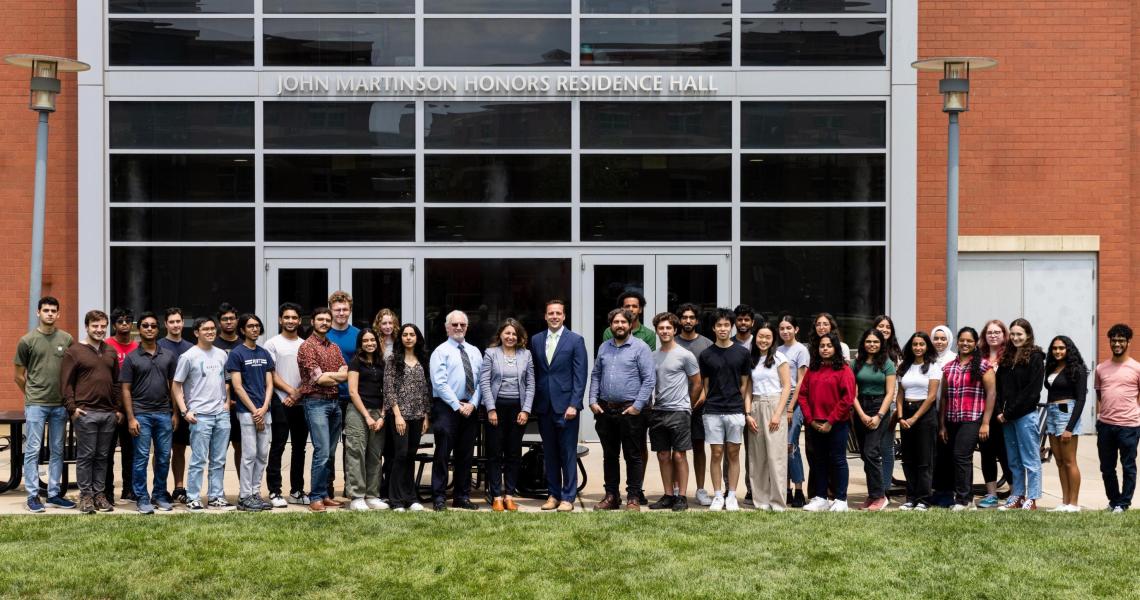
NJIT Honors College Creates Interdisciplinary Research Pipelines, read the article here.
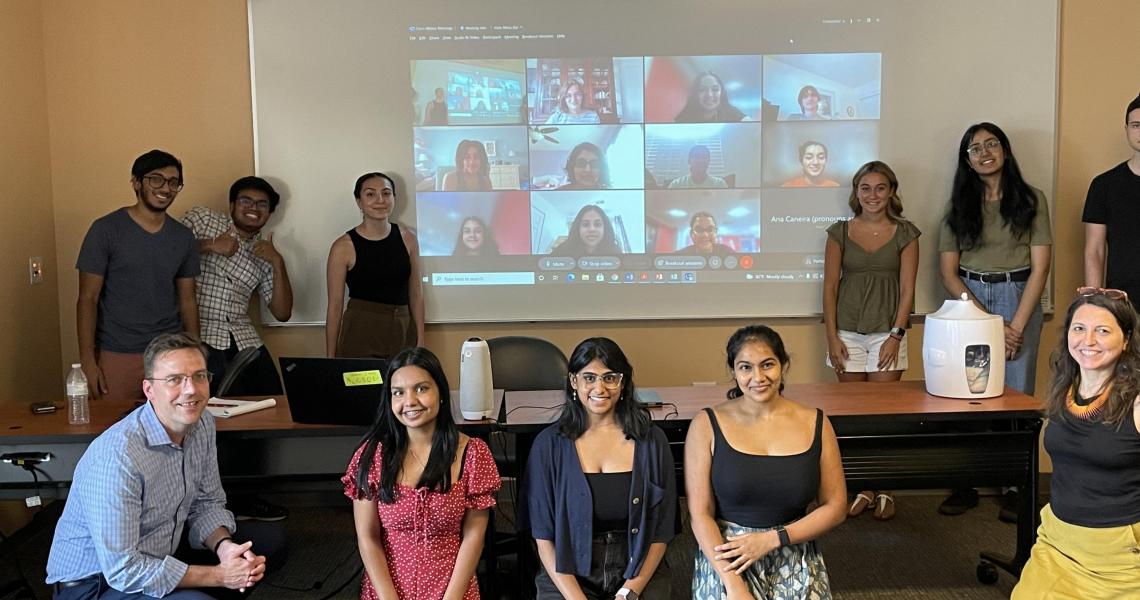
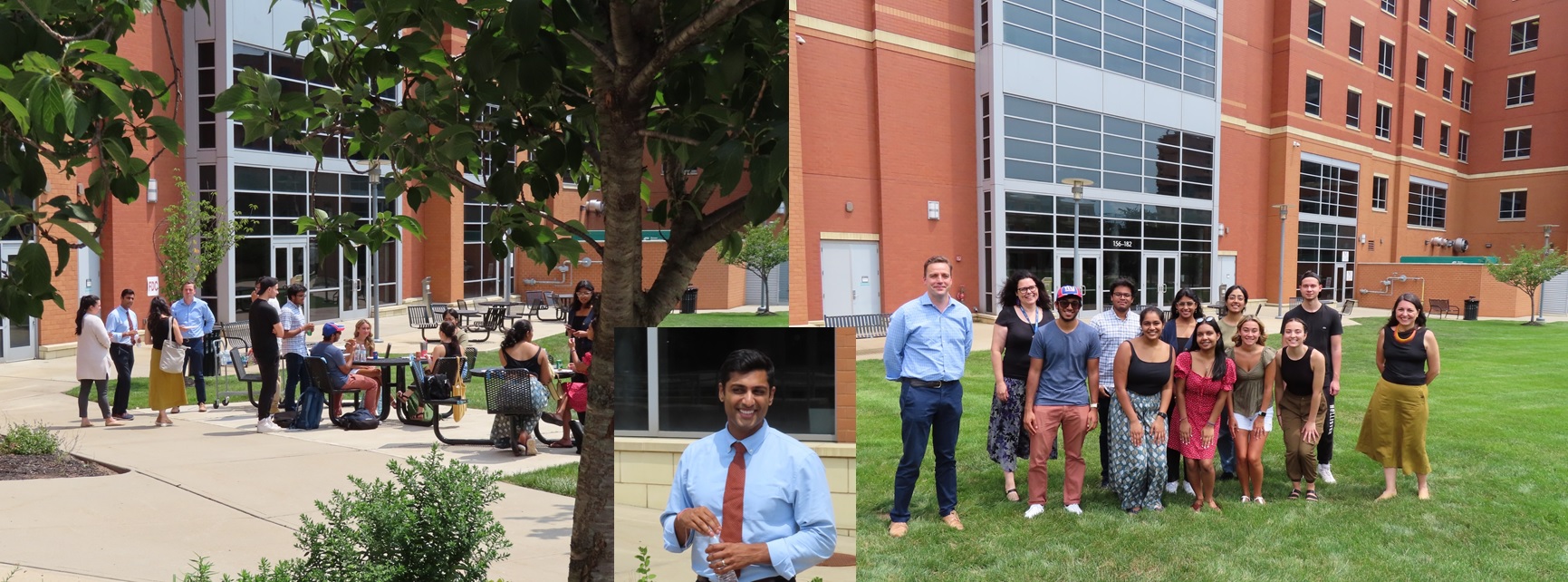
Read about the Honors College Debuts Program Promoting Undergraduate Research here.
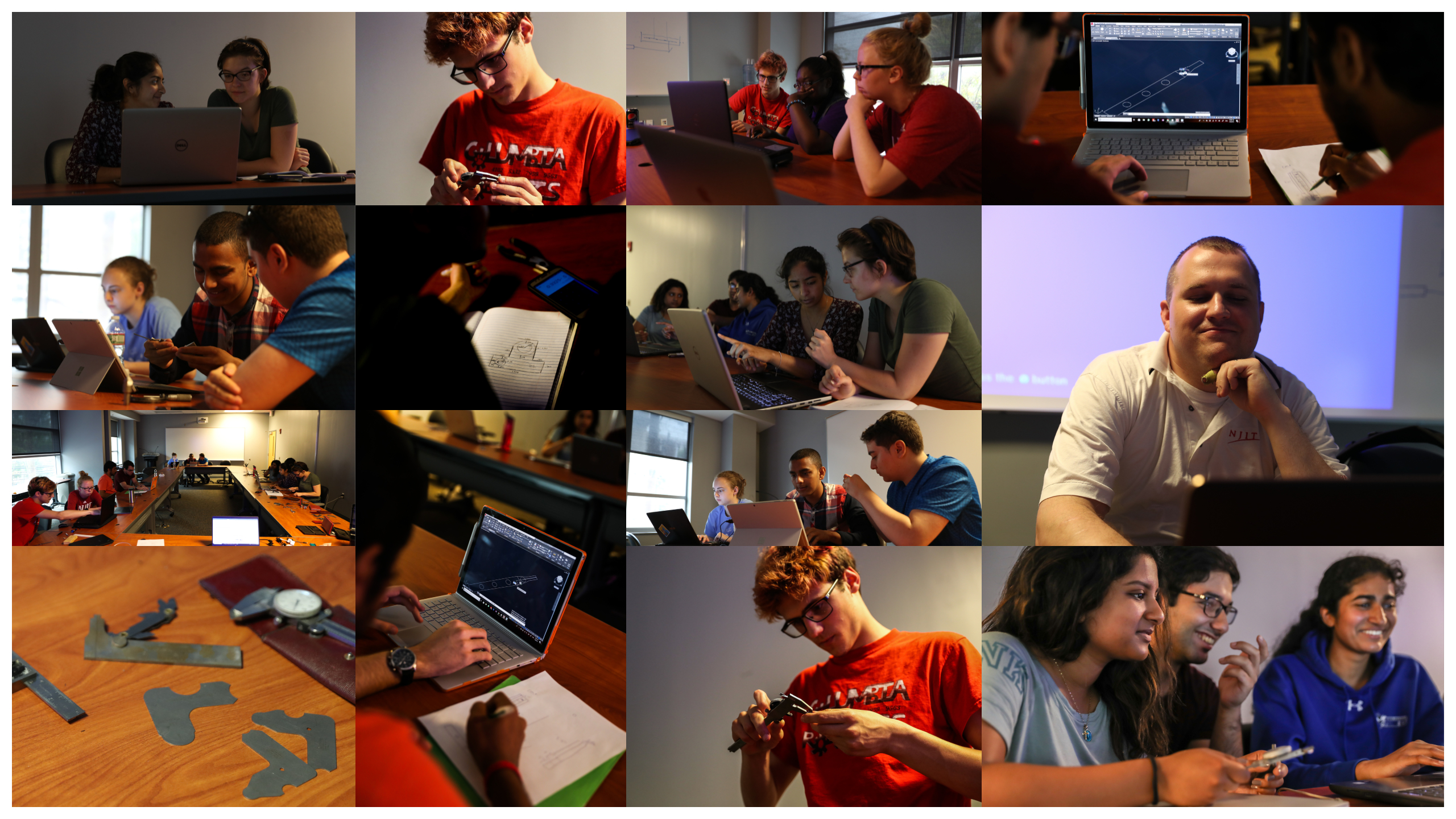
Collage of photos of the 2018 HSRI Recipients with Dr. Dobiszewski, click here to see complete gallary of photos.
NJIT's 11th International Undergraduate Research Symposium, read the article here.
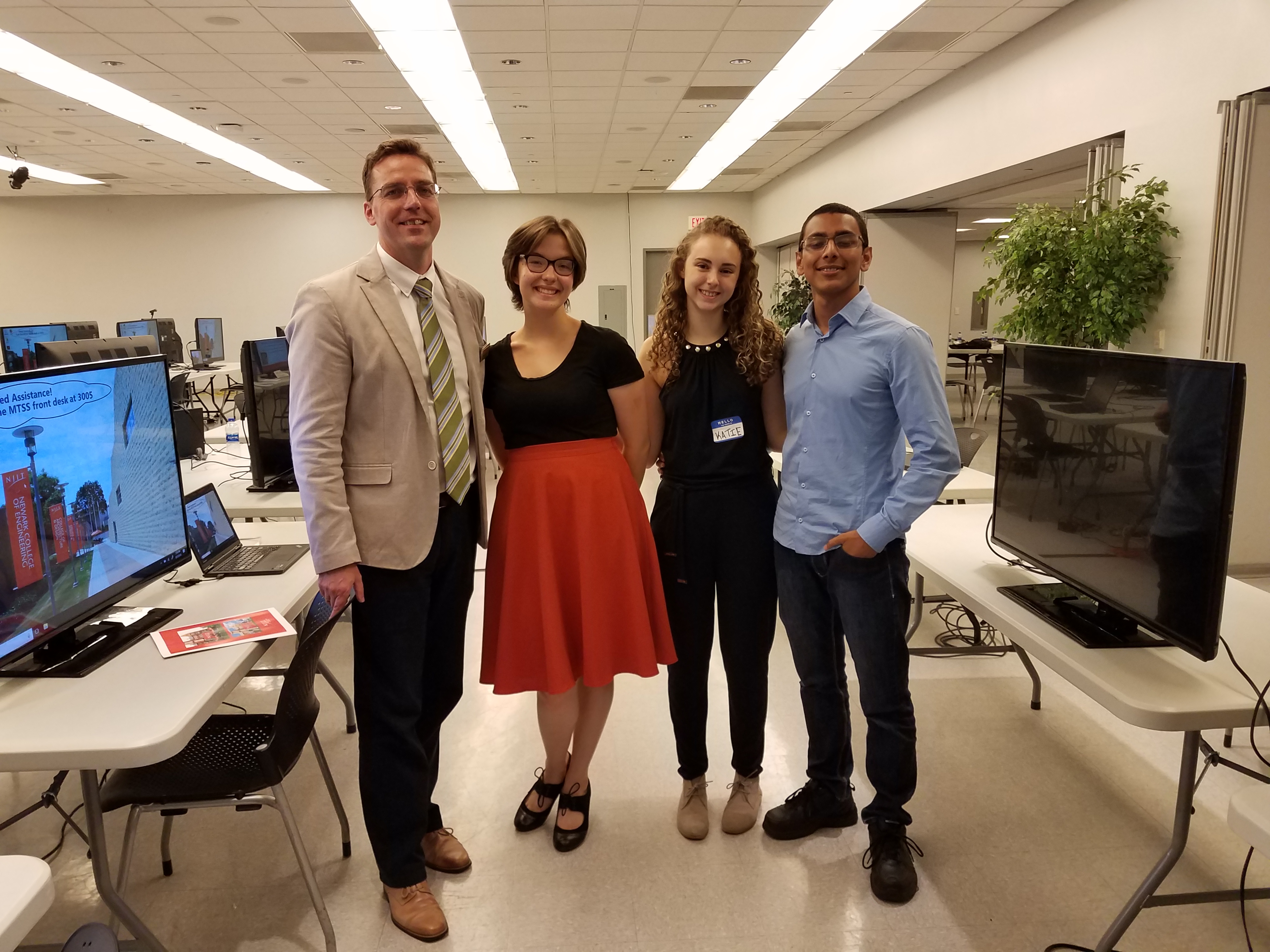
(Above, left to right) Dean Louis I. Hamilton, Honors College, Laura Gould, Katherine DeMottie, and Arif Uddin, just a few of the students who participated in the Undergraduate Research Symposium. Click here for a complete gallery of photos.
Undergraduate Research Snapshot: Jennifer Callaghan Investigates Bullet-Proof Armor, read the article here.
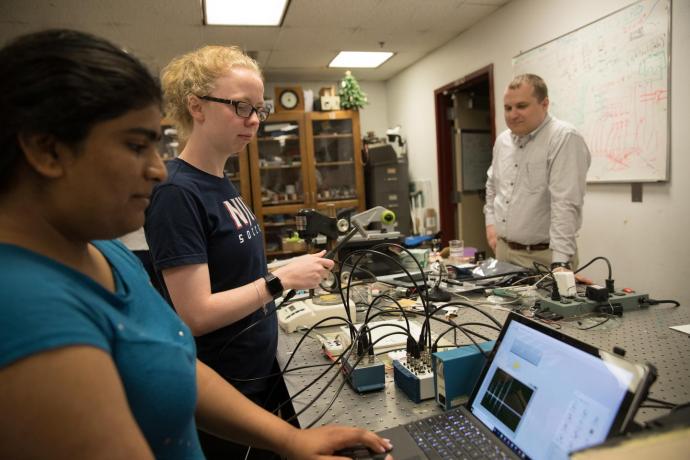
(Above) Jennifer Callaghan (center) and Ayushi Sangoi, a biomedical and chemical engineering major, use an impact hammer to conduct modal testing, a form of vibration testing, as adviser Kyle Dobiszewski looks on. This type of testing characterizes the frequency response of a sample material — in this case, a commercially available ballistic fiberglass panel. Their work is supported by an FY18 Faculty Seed Grant.